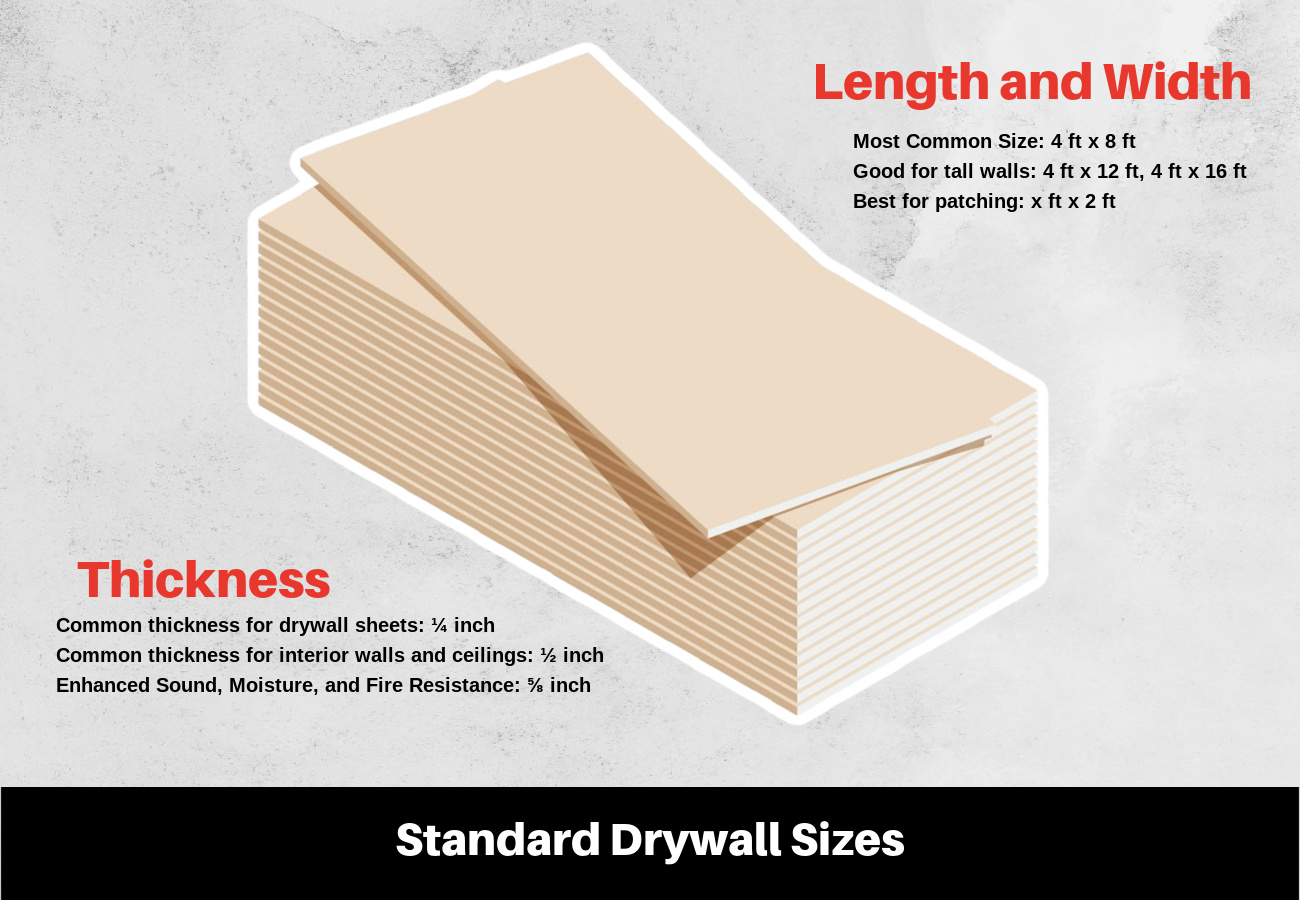All the available options for drywall sizes, including the length, width, and thickness, are central to drywall’s popularity in the building industry. These drywall sizes are standard throughout the building industry. Standard drywall sizing allows builders to more easily plan and install drywall in their project. It also helps keep the price of drywall lower because it allows for greater manufacturing efficiency.
The most popular drywall length and width is 4 feet x 8 feet, and the most common drywall thickness is ½ inch. There are numerous lengths, widths, and thicknesses that manufacturers create for the wide range of projects where drywall is used. Whether you are beginning a home DIY project or a large-scale construction venture, knowing the available drywall sizes and their characteristics is key to a successful endeavor.

Drywall Sizes: Length and Width
Drywall length and width sizes are most commonly found with 4 feet as the standard width and the length varying. There are also special sizes if you need a drywall sheet that is smaller or longer than average.
- 4 feet x 8 feet – This drywall size is used in both residential and commercial construction for walls and ceilings. This size is common for DIY use as it is easier to lift and maneuver.
- 4 feet x 10 feet – This drywall size offers a middle ground between 8 and 12-foot lengths, offering some flexibility in installation.
- 4 feet x 12 feet – 4 x 12-foot panels are suitable for covering large expanses like ceilings and walls with fewer seams.
- 4 feet x 14 feet – Large panel sizes like 4 x 14 feet reduce the number of seams, but their weight is cumbersome for the average DIYer.
- 4 feet x 16 feet – 4 x 16-foot panels are not a common size, but they are available for specialty projects.
Drywall Sizes: Thickness
The thickness of drywall sheets determines its structural properties, sound insulation, and fire-resistance capabilities. In general, the thicker the drywall, the better the sound and fire resistance, but you should weigh this with your budget constraints as thicker drywall is more expensive.
- ¼ inch – This is not a common thickness for drywall sheets. Builders use ¼ inch thickness drywall as a covering for existing walls or for following a curved profile due to its flexibility. ¼ inch drywall is the most cost-effective option.
- ⅜ inch – Builders often use ⅜ inch drywall for repair work or to create a double wall for soundproofing.
- ½ inch – ½ inch thick drywall is the most common thickness for interior walls and ceilings in residential construction. This thickness is suitable for most interior applications.
- ⅝ inch – This drywall is used when ceilings or walls require more thickness to enhance sound insulation and moisture and fire resistance. ⅝ inch thick drywall is more expensive and heavier than other drywall thicknesses.
How to Choose the Right Drywall Size
Deciding on the right size drywall involves weighing multiple factors. Here are some guidelines to help you make an informed choice.
- Identify the Purpose of the Space
Consider the function of the room where you will be installing the drywall. Identifying whether the room is a bathroom, bedroom, home theater, playroom, or living room makes a difference in what size and thickness of drywall you need. Each of these spaces will have different needs for moisture and fire resistance and sound insulation.
- Check Building Codes and Regulations
Research the building requirements in your area for your design. These may dictate the thickness and fire rating of the drywall that you need to use. Complying with local codes will allow you to avoid problems during the inspection process.
- Determine Structural Requirements
Consider the structural demands of the space. For certain areas like ceilings you may opt for ⅝ inch thick drywall for greater fire resistance and sound insulation. Load-bearing walls may require thicker drywall to add greater strength.
- Evaluate Sound Insulation Needs
In rooms like home theaters or homes in noisy environments, thicker drywall will reduce sound transmission from one room to another or between the exterior and interior. Adding a gap between layers of drywall can also help to reduce sound transfer.
Areas prone to fire including kitchens and garage-facing walls might require thicker, fire rated drywall. The fire-rating of the drywall increases with thickness. ⅝ inch thick drywall is the most fire-resistant.
- Consider Aesthetic Factors
The size and thickness of the drywall can impact the appearance of the finished project. Larger drywall sheets will reduce the number of seams between sheets. Thicker drywall has a more substantial appearance and hides wall imperfections better.
The thicker the drywall, the more expensive. Also, large, specialized drywall sizes are more expensive. You must balance the cost of more expensive drywall with aesthetic, safety, and structural concerns.
- Consult with a Professional
Balancing all the competing factors can be difficult for the novice home builder. Consult with builders, designers, and engineers if you are unsure about the best drywall size for your project. They can provide valuable insight based on their experience and expertise.


